The purpose of this model lesson plan is to help English for Academic Purposes (EAP) students grasp two important concepts when writing coherent introductions: progressing from the general to specific (G to S) and starting from the familiar to new (F to N). Studies show that EAP students often feel intimidated, anxious and discouraged when facing the daunting task of writing academic English essays. These negative feelings reduce their production speed and prevent them from achieving greater academic success. While attending a graduate writing seminar offered by the Department of Psychology to students in the sciences at National Taiwan University, I had the privilege of observing a favorite assignment taught by Visiting Professor Arthur Woodward and co-sponsored with Professor Yunnwen Lien, Director of the Thinking Laboratory.
The design of the assignment shifts the traditional emphasis from English language proficiency to a new approach using cognitive psychology and skill-acquisition learning theories. In his course, Woodward provided challenging, domain-specific writing exercises to his students every week, and supported this with regular professional feedback in a non-threatening environment. At the end of the semester, he reported an increase in the efficiency of student learning due to a reduction in anxiety and an increase in motivation and confidence when writing in academic English.
Because a coherent introduction begins with what is general and familiar to the audience before progressing to the specific and new, authors must take care to guide their audience through a journey that begins broadly and generally with a context and background of their research topic, before delving into their own uniquely complex and specific research. The following lesson plan has been designed as a prototype that can be used by individual departments to teach scientific writing skills that can help students structure their ideas and present scientific research quickly and effectively in English.
Students must first master the concepts of reader-focused introductions with concision and cohesion, before we move into the heart of coherence. This lesson plan uses "visual essays" to introduce two theoretical concepts to students that they can master later, without anxiety. The "visual essay" is intended as a metaphor, or representation, of the progression of ideas in an academic introduction. "Visual essays" are constructed with images of a single subject delivered with a spoken narrative. The progression of images is a visual tool for students to understand the concepts of general to specific (G to S) and familiar to new (F to N) as a movement in perspective. By comparing this movement in perspective to a camera lens that can widen and narrow its focus on a subject-image, the assignment builds a visual and spatial trajectory, plotting each point on a grid. This assignment was given in two-parts, during the seven and eighth week of the semester, and can be completed within 100 minutes, using PowerPoint slides.
In the first part of the assignment we introduced the theoretical component. We showed two versions of an essay on the topic of the founding of the tenth University of California campus in Merced and asked them which essay was a better explanation of the subject, and why. Both essays consisted of five Google Maps satellite images, delivered with a spoken narrative (Table 1 and slides). Essay 1 showed a series of Google Maps of the town of Merced and nearby highways, and then ended with maps of the campus. Essay 2 began with a satellite image of earth, then gradually zoomed in to focus on the region around Merced and the campus. Students felt the second essay better explained the subject, but could not articulate why. We hinted that the second essay moves along two dimensions, and asked them to identify what these dimensions were. The audience, who were Taiwanese graduate students and knew little about the Universities of California, felt that the second essay took into account their perspective. After some discussion, they were able to identify two ways in which the second essay moved from the general to specific (G to S), and familiar to new (F to N). Unlike Essay 1, which began with directions on how to get to the campus of Merced, Essay 2 used a NASA satellite image of earth to situate Taiwan in relation to the western United States. Furthermore, the spoken narrative noted differences between Taiwanese and American students before describing the needs and demography of the population around Merced, and how the university caters to these needs.
Table 1. Comparing "Visual Essays"
| Title |
UC Merced |
Where is UC Merced and what did it look like |
| Slide 1. |
Highway 99 leading to town of Merced. |
NASA image of earth with arrows pointing to Taiwan and Merced. |
| Slide 2. |
Highway 140 exiting town of Merced. |
Google map of western United States showing a rim of red mountains and the valley around Merced which is populated by poor people whom the 10th campus is intended to serve. |
| Slide 3. |
Neighboring town Le Grand. |
Aerial photo of farming town and campus of Merced near lake. |
| Slide 4. |
Small farming town of Merced. |
Closer aerial photo of the campus in relation to the larger nearby lake. |
| Slide 5. |
New University of California campus of Merced. |
Close-up aerial photo of campus. |
| |
| Spoken Narrative: |
Describes details about University of Merced, the highways that lead to the town of Merced, and the buildings of the campus. |
Compared Taipei and Merced in terms of geographic location and other similarities and differences. Described the poor people living in the valley around Merced, and why the location is suited for American students. |
"Visual Essay" 1. Title: "UC Merced" (5 Slides)
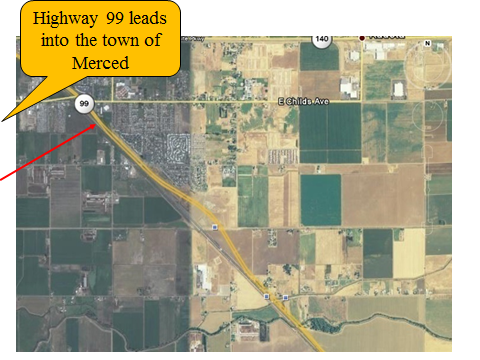 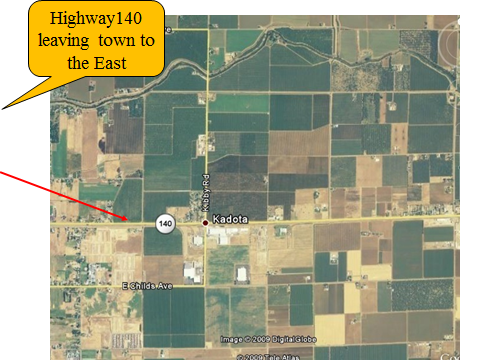 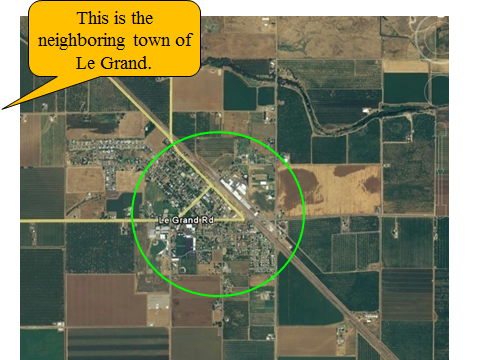 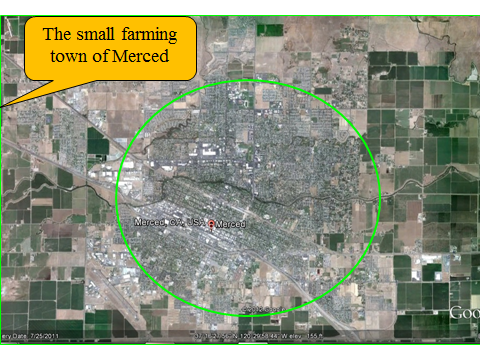 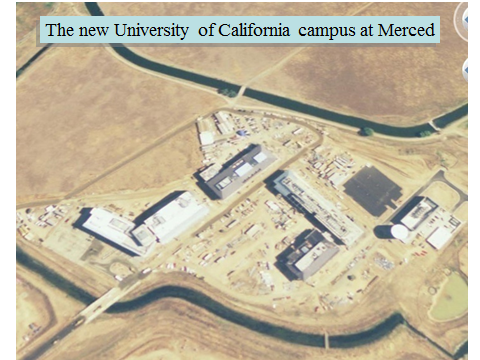
"Visual Essay" 2. Title: "Where is Merced and what did it look like in 2008?"
(5 Slides)
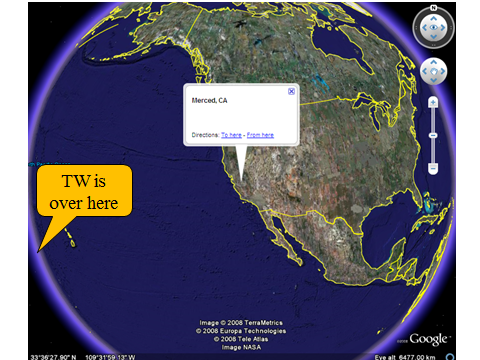 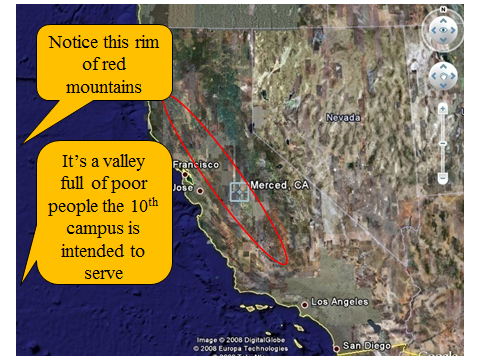 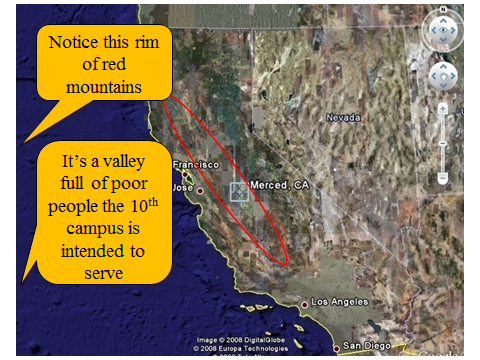 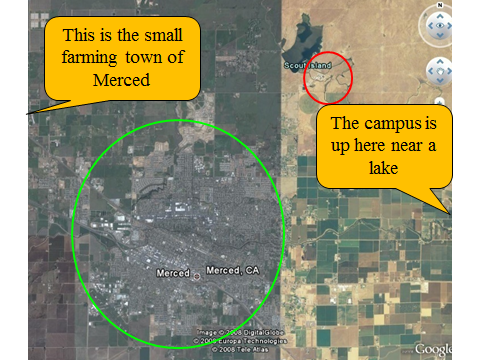 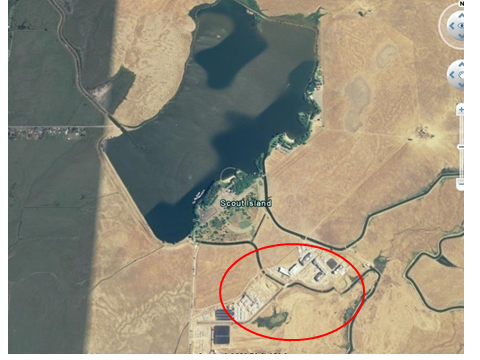
Instead of a lecture with technical jargon, we used a conceptual approach to help students grasp two concepts. This simple, visual method cleverly and effectively presents an idea that students can go back and master later, without anxiety. The technique simplifies the writing process by focusing on the conceptual and spatial organization of ideas, rather than micro-concerns of grammar and word choice. The interactive nature of the design, in which students guess why one essay is superior to another, trains students to differentiate strong from weak introductions in their own writing. Perhaps most importantly, the concept can be applied across disciplines, since the guiding principle can be taught without the use of specialized jargon. Finally, the images are unforgettable, which helps the idea "stick". Using this theoretical exercise, students identified the principles themselves, an enlightening experience they won't easily forget.
In part two of the assignment, we introduced a practical application. We reviewed how coherence in a paragraph is built when each sentence is logically and meaningfully related to the next sentence, and strengthened when the sentences in the paragraph progress from general to specific (G to S), and familiar to new (F to N). To illustrate this idea, students asked to look at the introduction of a prominent article in their field, and plot each sentence of the introduction onto a two-dimensional graph, whose intersecting axes were the dimensions of general to specific (G to S) and familiar to new (F to N) (Graph 1). After all the sentences were plotted and connected, the students could see an trajectory from the top left quadrant, which represented the general and familiar, to the bottom right quadrant, which represented the specific and new.
Graph 1.
Sentences within a paragraph plotted on a two-dimensional graph
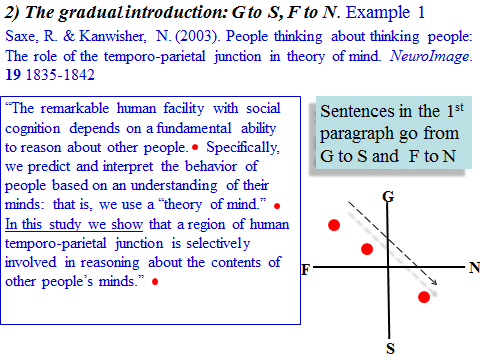
By visually tracking the progression of sentences from general to specific (G to S) and familiar to new (F to N), students could easily observe the pattern of how coherence is constructed. Part two demonstrates how authors of published articles follow a logical progression by carefully ordering the ideas in their introductions. They must first establish a broad perspective and familiar context to connect with their readers before they can describe the specific findings of their studies. These concepts were lacking thus far in the students' writing in the class. However, by observing that the concept of general to specific (G to S), can easily be achieved simply by knowing the content and introducing it in order, and that the second concept of familiar to new (F to N) simply requires keeping the readers in mind by starting with what they know, and not with what the author knows, students realized that they could consciously vary these two dimensions as they write. Interestingly, part two of the assignment can also be applied to the progression of topic sentences across paragraphs. Using a multi-paragraph introduction from a published article, we plotted the topic sentences of the first six paragraphs (i.e., the first sentence of each of the first six paragraphs that formed the introduction) on a two-dimensional graph, using (G to S) and (F to N) as intersecting axes. The connected points showed a similar movement from general and familiar to specific and new, demonstrating that the topic sentences of a multi-paragraph introduction will follow the same logic as the structure of an essay, with the ordering of ideas progressing from general to specific (G to S) and familiar to new (F to N).
In conclusion, this assignment uses both theoretical and practical components to present and illustrate two important concepts in writing coherent introductions. It is designed in a way that students can easily grasp without the use of technical jargon. The "visual" and cognitive approach is an effective way to teach difficult writing concepts with a fresh perspective in a way that students can easily remember and apply to their own writing.
Notes:
This report was prepared based on a course offered at the Department of Psychology, NTU, co-taught by Visiting Professor Arthur Woodward and Professor Yunnwen Lien, Director of the Thinking Laboratory.
|

